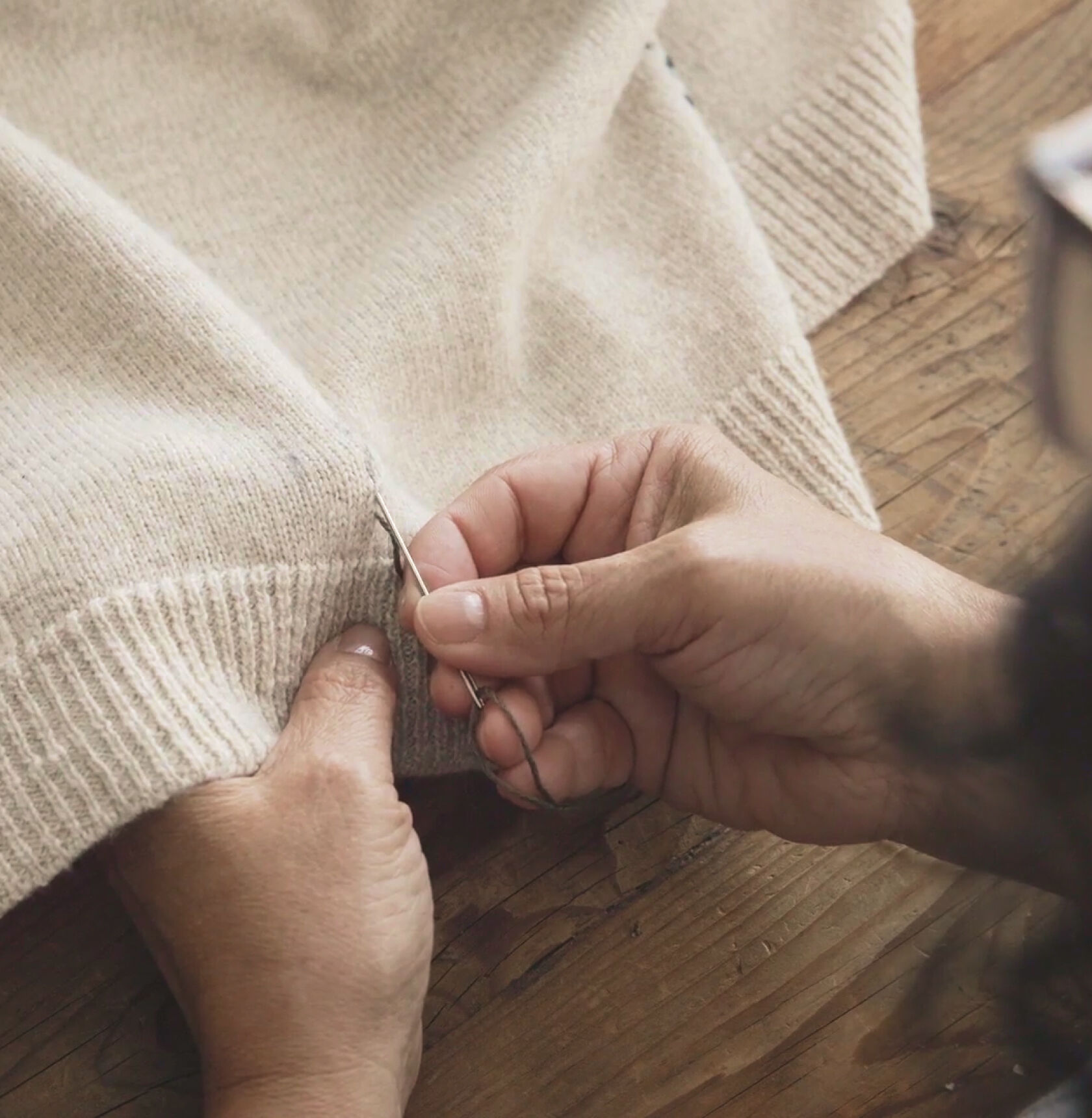Visible Mending 101: Stitching
A minor flaw doesn’t have to mean the end of a favorite piece. In the first installment of our series on visible mending, learn how a simple stitching technique can turn clothing from the discard pile into one-of-a-kind works of art.
Our clothes are designed to wear beautifully over time—but it’s inevitable that accidents will happen. When it comes to stains, most can be removed (see our care guide for tips), but some are stubborn and set forever. Rather than tossing your favorite shirt or pair of pants, consider turning that red wine or coffee splotch into an eye-catching detail with a visible mend.
“Visible mending” refers to decorative fabric repairs that are meant to stand out. This technique can include everything from embroidery to darning to patching using contrasting colors and fabrics, and can transform damaged clothes into statement pieces that proudly show their wear. It’s an approach that embodies so much of what we love about wearing and re-wearing the pieces in our wardrobes. Instead of being shoved into the back of a closet, or worse, ending up in a landfill, anything from a simple tee to a silk dress can become a beautiful testament to a life well-lived.
Plus repairing your own clothing is fun and empowering. Not only can you salvage pieces from your wardrobe, you can also learn a new skill—one you can experiment with to form your own distinct creative style.
Rescuing our thoughtfully made clothes from early retirement is hugely important to us—it’s the reason behind our take-back and re-sale program Renew, which has collected two million used garments since 2009 to be resold or remade.

Lesson 1: Stitching
For our first installment, Rosibel Chavez, Senior EILEEN FISHER Sample Maker & Patternmaker, demonstrates a technique she developed for our Renew Visible Mending Collection, an annual limited-edition collection using lightly damaged pieces from our past seasons.
Learn to recreate her designs at home using the video above and detailed steps below—it’s a simple stitching fix with endless possibilities for camouflaging minor flaws, and a great starting place if you’re new to sewing. We hope it gives you the tools to try your own visible mend at home, and colorfully extend the life of your clothes.
The Steps

Step 1
Gather Supplies
You will need embroidery thread, scissors, and a standard sewing needle.

Step 2
Choose an Item to Repair
This technique works best on minor flaws, such as stubborn spots or pulled thread. Stay tuned for future guides on dealing with holes and rips.

Step 3
Prepare Your Needle & Thread
The amount of thread you’ll need will depend on the size of the area you’re covering. For the mend in this example, the thread was about 12 inches long, folded in half. If you’re not sure exactly how long to cut, just make a best guess—this technique is forgiving, and you can always rethread and restart.
Thread your needle, pulling the end through to create a double length. Tie the two loose ends together with a small knot, then use your scissors to trim off any extra thread as close to the knot as possible.

Step 4
Begin Stitching
Start a row by inserting the needle from the underside of the fabric, and slightly below and to the right of the flawed area. Begin stitching vertically using a simple up-and-down stitch—officially known as a running stitch. Thread a few stitches at a time, then gently pull taut. It’s okay if your stitches aren’t exactly even—part of the beauty of this design is the perfectly imperfect pattern it creates.

Step 5
Continue the Pattern
When you’ve reached the top of the area you want to cover, move your needle slightly to the left and repeat the process going the other direction, to create a parallel line of decorative stitches.

Step 6
Tie Off
When you’re happy with your final design, secure your thread by backstitching twice on the underside of the fabric, pulling the thread taut and trimming it close to the knot.

Step 7
Admire Your Handiwork
Enjoy your newly restored piece of clothing—and the compliments that come with it.
Get Creative
Once you master the basic technique, start experimenting. Try mixing and matching bright colors of thread, dramatically varying the lengths of your stitches or rows, or spacing each row closer together for a denser pattern.
If you love the way this mend looks on a sweater, try it out on a tee or even a pair of socks. You can also use a piece of scrap fabric to practice different variations and see what you like best before tackling the rest of your wardrobe.

